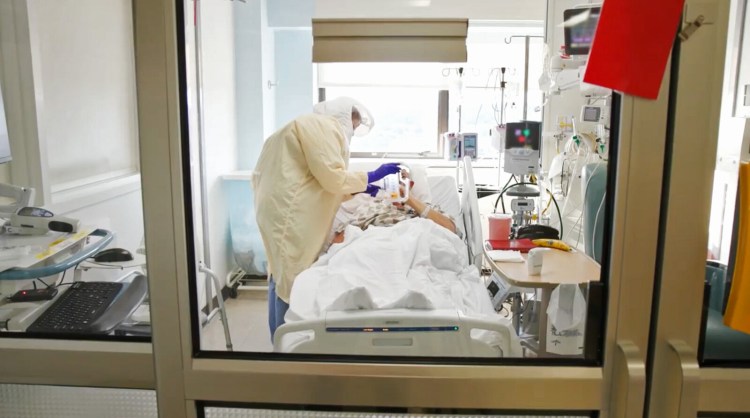More people hospitalized in Maine with COVID-19 are breathing with the assistance of ventilators than at any previous time during the pandemic as the delta variant continues to sweep through the state’s unvaccinated population.
The Maine Center for Disease Control and Prevention reported on Monday that there are currently 40 people on ventilators, surpassing the previous peak of 37, which occurred on both Sept. 10 and Jan. 21 of this year. And Maine hospitals continue to care for near record levels of other patients, both in and out of intensive care units.
“Stat of the day: there are 194 people in the hospital with COVID-19 in Maine right now,” Dr. Nirav Shah, director of the Maine CDC, said in a tweet Monday. “Sixty-seven of them are in the ICU, and 40 are on ventilators. Two weeks ago, there were 136 people hospitalized, with 69 in the ICU and 28 on ventilators. Statewide, there are 64 ICU beds available.”
The Maine CDC does not track the vaccination status of people on ventilators. However, nearly 100 percent of people in the ICU on some days – and 70 to 75 percent of all those hospitalized – are not fully vaccinated against COVID-19, the Maine CDC has said.
Ventilators are used for the most critically ill patients. About 45 percent of ventilated COVID-19 patients die, according to a January 2021 review of 69 studies by the National Institutes of Health.
Dr. Laura Blaisdell, a South Portland pediatrician and infectious disease expert, said there are some studies that show the delta variant, in addition to being more contagious, also causes more severe disease, but the studies are not conclusive.
“Is the delta variant more virulent? Or do we just have a bigger denominator of people who are sick? That is one of the major questions we are trying to figure out,” Blaisdell said.
Another mystery is that there are some recent reports nationally of young, healthy people becoming extremely ill or dying, she said.
“We’re learning so much about COVID-19 and yet there are healthy people becoming quite ill with COVID for no apparent reason. That is truly an enigma about this disease,” Blaisdell said.
The state doesn’t publish ages of people on ventilators in Maine, and no breakdown was available Monday.
Maine’s hospital executives have pleaded with eligible people who have not yet gotten their shots to do so to save hospital capacity. MaineHealth, the Maine’s largest health care network with Maine Medical Center in Portland and seven other hospitals in the state, announced last week that it was postponing some elective surgeries to maintain capacity for COVID-19 patients. Examples of postponed surgeries include knee and hip replacements, and other surgeries that can safely wait.
In addition to encouraging people to get vaccinated, federal and state governments are increasingly mandating COVID-19 vaccination.
President Biden last week introduced new vaccine mandates that will require employers with 100 or more workers to have their employees get immunized or tested weekly for COVID-19, among other new vaccine requirements. Dr. Anthony Fauci, director of the National Institute of Allergy and Infectious Diseases, said in news reports on Monday that he supported vaccination requirements for air travel.
Maine will enforce its mandate that health care workers get their shots beginning Oct 29.
The state has one of the highest vaccination rates in the nation, with 72.7 percent of the 1.18 million people eligible for the vaccine – ages 12 and older – receiving their final dose of the vaccine. But that still leaves nearly 325,000 Maine people who are unvaccinated and eligible to get immunized.
Unvaccinated populations vulnerable to the more contagious delta variant are the primary reason why COVID-19 cases have spiked starting in late summer. Ninety-five percent of the 44,737 COVID-19 cases since most Maine people were eligible for vaccination have occurred in the unvaccinated population, according to the Maine CDC.
Despite recent increases in case counts, Maine’s 26.3 cases per 100,000 residents is below the national average of 44 per 100,000. Connecticut has the lowest case rate in the nation at 15.2 per 100,000, while West Virginia, Kentucky and Tennessee have the worst rates in the nation, with each more than 90 cases per capita.
Send questions/comments to the editors.




Comments are no longer available on this story